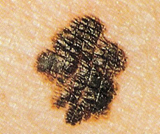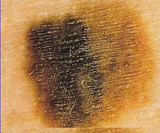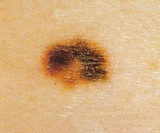Perform a Skin Self-Exam Once a Month
The American Academy of Dermatology (AAD) recommends that people perform a skin self-exam once a month.
Research shows that this can can lead to early detection of skin cancer, including melanoma. When detected early, most skin cancers can be treated successfully.
Everyone should examine their skin for suspicious moles and changes to the skin that may be precursors of skin cancer.
Get Help From a Spouse or Friend
Ask for help from someone close to you. It's more enjoyable and effective at examining hard-to-see areas, such as your back. Eliciting their assistance may inspire them to check their own skin too.
Getting Started
The best time to examine your skin is immediately after a shower or bath. Check your skin in a well-lit room using a full-length mirror and handheld mirror.
It’s helpful to be familiar with where your birthmarks, moles, and blemishes are located and what they usually look and feel like.
Use a Body Mole Map to record where spots appear on your skin. You can refer to the Body Mole Map the next time you perform a skin exam to determine if there have been any changes.
Check Yourself from Head to Toe
By checking your skin regularly, you will become familiar with what is normal for you. It may be helpful to record the dates of your skin exams and write notes about the way your skin looks. If you find anything unusual, see your doctor right away.
What to Look for During a Skin Self-Exam
As you or your partner examines your skin, look for changes in the size, color, shape, or texture of any marks on your skin.
Signs of skin cancer include:
- Mole that is different from the rest, itches, bleeds, or is changing in any way — even if the mole is smaller than 6 millimeters (about the size of a pencil eraser)
- Sore that never fully heals
- Translucent growth with rolled edges
- Brown or black streak underneath a nail
- Cluster of slow-growing, shiny pink or red lesions
- Waxy-feeling scar
- Flat or slightly depressed lesion that feels hard to the touch
Tell your doctor if you find a suspicious lesion
Keep in mind the ABCDEs of melanoma detection
- "A" for Asymmetry: Does one half of a mole look different from the other?
- "B" for Border: Is the edge (border) of the mole ragged, notched, or blurred?
- "C" for Color: Does the mole have a variety of hues or colors within the same lesion? (The color is uneven and has shades of black, brown, and tan? Are there areas of white, grey, red, pink, or blue?)
- "D" for Diameter: Is the mole wider than 6mm or 1/4 inch? (the width of a pencil eraser). Or has there been an increase in size?
- "E" for Evolving: Does the mole or skin lesion look different from your other moles or has it changed in shape color, size or other trait?
Melanomas can vary greatly in how they look. Many show all of the ABCDE features. However, some may show changes or abnormalities in only one or two of the ABCDE features.
If you see a mole or new spot on your skin that has any of the ABCDEs, immediately make an appointment to see your doctor.
Note: Do not use the photographs above to try to diagnose melanoma yourself. Pictures are useful examples, but they cannot take the place of a doctor’s examination.
 |
 |
 |
 |
See your doctor if you notice a mole that is different from others, or which changes, itches, or bleeds even if it is smaller than 6 millimeter.
Always tell your doctor if you find a suspicious lesion
Contact your doctor if you or your partner finds a suspicious lesion. Inform the person making the appointment why you want to see the doctor. Skin cancer has a high cure rate when detected early.
Source: Vivacare
Last updated : 1/8/2019